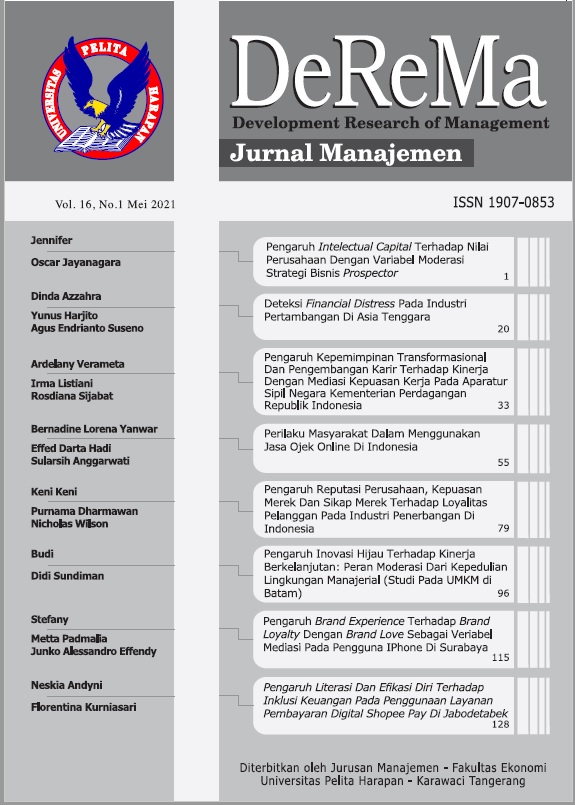PENGARUH LITERASI DAN EFIKASI DIRI TERHADAP INKLUSI KEUANGAN PADA PENGGUNAAN LAYANAN PEMBAYARAN DIGITAL SHOPEE PAY DI JABODETABEK [THE EFFECT OF LITERATION AND SELF-EFFICIENCY TOWARDS FINANCIAL INCLUSION ON THE USE OF SHOPEE PAY DIGITAL PAYMENT SERVICES IN JABODETABEK]
DOI:
https://doi.org/10.19166/derema.v16i1.3150Keywords:
Shopee Pay, financial inclusion, financial literacy, financial technology, digital payment, inklusi keuangan, literasi keuangan, efikasi diri, teknologi finansial, pembayaran digitalAbstract
The advancement of digital technology had affected many industries included financial sectors. The most famous financial technology was digital payment services. Financial technology was expected to support the Indonesian government program to increase financial inclusion. The objective of this study is to analyze the effect of financial literacy and self-efficacy to increase financial inclusion using the Shopee Pay digital payment services in Jabodetabek region as its research object. This is a causal research with quantitative methods and non-probability sampling techniques. This research distributed questionnaires among 191 respondents and furthered analyzed with linear multiple regression using IBM SPSS 26. The findings of the research showed that financial literacy and self-efficacy had a positive effect into financial inclusion.
Abstrak dalam Bahasa Indonesia Perkembangan teknologi digital berpengaruh pada berbagai macam industri termasuk industri keuangan. Salah satu layanan keuangan berbasis teknologi yang paling popular adalah pembayaran digital. Teknologi finansial ini diharapkan dapat mendukung program pemerintah Indonesia dalam meningkatkan inklusi keuangan. Tujuan penelitian ini adalah untuk mengetahui pengaruh literasi dan efikasi diri pada bidang keuangan terhadap tingkat inklusi keuangan dengan objek penelitian layanan pembayaran digital Shopee Pay di wilayah Jabodetabek. Penelitian ini merupakan penelitian kuantitatif dan menggunakan teknik non-probability sampling. Penelitian ini menyebarkan kuesioner terhadap 191 responden dan selanjutnya diolah secara statistic dengan menggunakan IBM SPSS 26 dan metode regresi linear berganda. Hasil penelitian ini menunjukkan bahwa literasi keuangan dan efikasi diri pada keuangan berpengaruh positif terhadap inklusi keuangan.
References
Alliance for Financial Inclusion. (2010). Financial inclusion measurement for regulators: Survey design and implementation. 1-22.
Atkinson, A., & Messy, F. (2013). Promoting financial inclusion through financial education.pdf. OECD Publishing, 34. https://doi.org/10.1787/5k3xz6m88smp-en
Atkinson, A., & Messy, F.-A. (2011). Assessing Financial Literacy in 12 Countries. https://papers.ssrn.com/sol3/papers.cfm?abstract_id=1809679
Bandura, A. (1978). Self Efficacy: Toward A Unifying Theory of Behavioral Change. Advances in Behaviour Research and Therapy, 1(4), 139-161. https://doi.org/10.1016/0146-6402(78)90002-4
Bongomin, G. O. C., Munene, J. C., Ntayi, J. M., & Malinga, C. A. (2017). Financial literacy in emerging economies: Do all components matter for financial inclusion of poor households in rural Uganda? Managerial Finance, 43(12), 1310-1331. https://doi.org/10.1108/MF-04-2017-0117
Bongomin, G. O. C., Munene, J. C., Ntayi, J. M., & Malinga, C. A. (2018). Nexus between financial literacy and financial inclusion. International Journal of Bank Marketing. https://doi.org/10.1108/ijbm-08-2017-0175
Carpena, F., Cole, S., Shapiro, J., & Zia, B. (2011). Unpacking the Causal Chain of Financial Literacy. The World Bank Development Research Working Paper, 1-36. https://papers.ssrn.com/sol3/papers.cfm?abstract_id=1930818
Choi, Y., & Sun, L. (2016). Reuse intention of third-party online payments: A focus on the sustainable factors of alipay. Sustainability (Switzerland), 8(2), 1-15. https://doi.org/10.3390/su8020147
Daily Social. (2018). Fintech Report 2018 (Issue 22613).
Demirguc-Kunt, A., Klapper, L., Singer, D., Ansar, S., & Hess, J. (2017). The Global Findex Database 2017: Measuring Financial Inclusion and the Fintech Revolution. Journal of Chemical Information and Modeling, 53(9). https://doi.org/10.1596/978-1-4648-1259-0
Demirguc-Kunt, A., Klapper, L., Singer, D., & Van Oudheusden, P. (2015). The Global Findex Database: Measuring financial inclusion around the world. https://globalfindex.worldbank.org/
DeNoyelles, A., Hornik, S., & Johnson, R. (2014). Exploring the dimensions of self-efficacy in virtual world learning: Environment, task, and content. Journal of Online Learning and Teaching, 10(2), 255.
Farjami, H., & Amerian, M. (2012). Relationship between EFL Learners’ Perceived Social Self-Efficacy and their Foreign Language Classroom Anxiety. Journal of English Language Teaching and Learning, 4(10), 77-103. https://elt.tabrizu.ac.ir/article_608.html
Farrell, L., Fry, T. R. L., & Risse, L. (2016). The significance of financial self-efficacy in explaining women’s personal finance behaviour. Journal of Economic Psychology, 54, 85-99. https://doi.org/10.1016/j.joep.2015.07.001
Fintechnews. (2018, May). Indonesia: Fintech Landscape Report. https://fintechnews.sg/20712/indonesia/fintech-indonesia-report-2018/
Ghozali, I. (2018). Aplikasi Analisis Multivariate Dengan Program IBM SPSS 25. Badan Penerbit Universitas Diponegoro.
Global Financial Development Report. (2014). Global Financial Development Report: Financial Inclusion. Economic and Political Weekly, 49(33). https://doi.org/10.9774/gleaf.9781315103457_5
Hair Jr., J., Black, W., Babin, B., & Anderson, R. (2014). Multivariate Data Analysis. Pearson Education.
Hiqmah, Faizatul (2019). Pendekatan Pemasaran Sosial Untuk Peningkatan Inklusi Keuangan Bagi Masyarakat Kurang Mampu. DeReMa (Development of Research Management): Jurnal Manajemen, 14(2), 269-284. https://doi.org/10.19166/derema.v14i2.1418
Kata Data. (2020). Hasil Dua Survei: Shopee Pay Kalahkan GoPay dan OVO Saat Pandemi. https://katadata.co.id/desysetyowati/digital/5f50a03bf2ece/hasil-dua-survei-shopeepay-kalahkan-gopay-dan-ovo-saat-pandemi
Katadata Insight Center. (2018). Indonesia e-commerce mapping 2018 9.9. Katadata Insight Center, 1-12.
Lown, J. M. (2011). 2011 oustanding AFCPE® Conference paper: Development and validation of a Financial Self-Efficacy Scale. Journal of Financial Counseling and Planning, 22(2), 54-63.
Massara, M., Mialou, A., & Amidzic, G. (2014). Assessing Countries’ Financial Inclusion Standing ”” A New Composite Index. https://doi.org/10.7172/2353-6845.jbfe.2017.2.5
Mindra, R., Moya, M., Zuze, L. T., & Kodongo, O. (2017). Financial self-efficacy: a determinant of financial inclusion. International Journal of Bank Marketing, 35(3), 338-353. https://doi.org/10.1108/IJBM-05-2016-0065
Mu, H.-L., & Lee, Y.-C. (2017). Examining the Influencing Factors of Third-Party Mobile Payment Adoption: A Comparative Study of Alipay and WeChat Pay. The Journal of Information Systems, 26(4), 247-284.
Otoritas Jasa Keuangan. (2013). Literasi Keuangan. https://www.ojk.go.id/id/kanal/edukasi-dan-perlindungan-konsumen/Pages/Literasi-Keuangan.aspx
Otoritas Jasa Keuangan. (2019). Siaran Pers Survei OJK 2019 Indeks Literasi dan Inklusi Keuangan Meningkat. https://www.ojk.go.id/id/berita-dan-kegiatan/siaran-pers/Pages/Siaran-Pers-Survei-OJK-2019-Indeks-Literasi-Dan-Inklusi-Keuangan-Meningkat.aspx
Putritama, A. (2019). The Mobile Payment Fintech Continuance Usage Intention in Indonesia. Jurnal Economia, 15(2), 243-258. https://doi.org/10.21831/economia.v15i2.26403
Remund, D. L. (2010). Financial literacy explicated: The case for a clearer definition in an increasingly complex economy. Journal of Consumer Affairs, 44(2), 276-295. https://doi.org/10.1111/j.1745-6606.2010.01169.x
Sekaran, U., & Bougie, R. (2016). Research Methods for Business. New York: John Wiley & Sons.
Shen, Y., Hu, W., & Hueng, C. J. (2018). The effects of financial literacy, digital financial product usage and internet usage on financial inclusion in China. MATEC Web of Conferences, 228. https://doi.org/10.1051/matecconf/201822805012
Snapcart. (2020). Riset Snapcart: Transaksi ShopeePay Lampaui GoPay dan OVO Saat Pandemi. https://katadata.co.id/desysetyowati/digital/5f43ad5910c56/riset-snapcart-transaksi-shopeepay-lampaui-gopay-dan-ovo-saat-pandemi
Strategi Nasional Keuangan Inklusif. (2018). Inklusi Keuangan Indonesia 2018.
We Are Social & Hootsuite. (2020). Digital Data Indonesia 2020. 1-97. https://datareportal.com/reports/digital-2020-indonesia
World Bank. (2018). Financial Inclusion. https://www.worldbank.org/en/topic/financialinclusion/overview
Zikmund, W. G., Carr, J. C., Babin, B., & Griffin, M. (2010). Business Research Methods. Mason, OH : South-Western Cengage Learning
Downloads
Published
Issue
Section
License
Authors who publish with this journal agree to the following terms:
1) Authors retain copyright and grant the journal right of first publication with the work simultaneously licensed under a Creative Commons Attribution License (CC-BY-SA 4.0) that allows others to share the work with an acknowledgement of the work's authorship and initial publication in this journal.
2) Authors are able to enter into separate, additional contractual arrangements for the non-exclusive distribution of the journal's published version of the work (e.g., post it to an institutional repository or publish it in a book), with an acknowledgement of its initial publication in this journal.
3) Authors are permitted and encouraged to post their work online (e.g., in institutional repositories or on their website). The final published PDF should be used and bibliographic details that credit the publication in this journal should be included.





